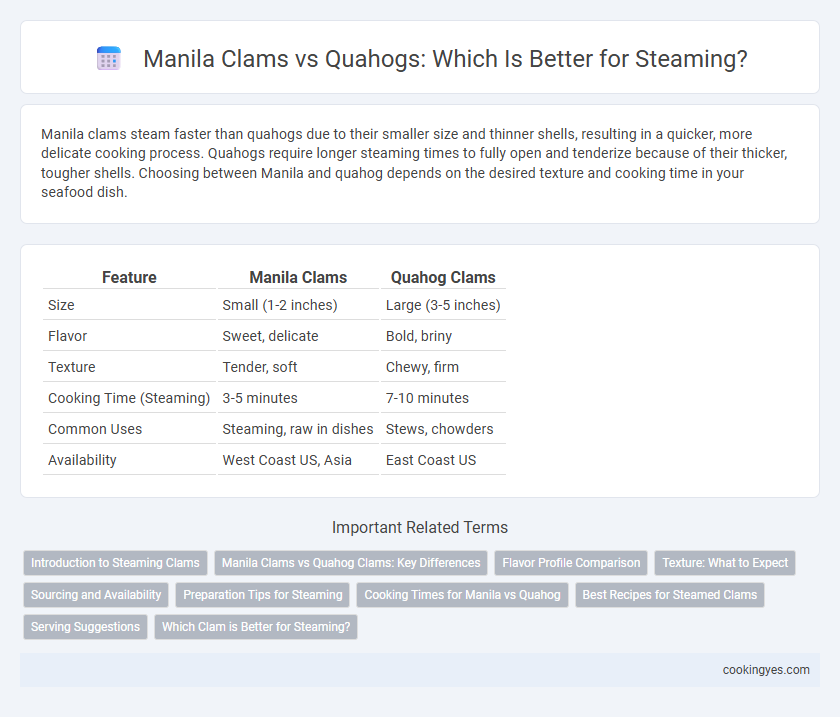Manila clams steam faster than quahogs due to their smaller size and thinner shells, resulting in a quicker, more delicate cooking process. Quahogs require longer steaming times to fully open and tenderize because of their thicker, tougher shells. Choosing between Manila and quahog depends on the desired texture and cooking time in your seafood dish.
Table of Comparison
| Feature | Manila Clams | Quahog Clams |
|---|---|---|
| Size | Small (1-2 inches) | Large (3-5 inches) |
| Flavor | Sweet, delicate | Bold, briny |
| Texture | Tender, soft | Chewy, firm |
| Cooking Time (Steaming) | 3-5 minutes | 7-10 minutes |
| Common Uses | Steaming, raw in dishes | Stews, chowders |
| Availability | West Coast US, Asia | East Coast US |
Introduction to Steaming Clams
Steaming clams requires a balance of heat, moisture, and timing to ensure optimal texture and flavor. Manila clams, known for their tender flesh and sweet briny taste, typically steam faster, opening within 5 to 7 minutes due to their smaller size. Quahog clams, with thicker shells and denser meat, demand longer steaming times, often 10 to 12 minutes, to fully cook and release their rich, robust flavor.
Manila Clams vs Quahog Clams: Key Differences
Manila clams are prized for their tender texture and slightly sweet flavor, making them ideal for quick steaming that preserves their delicate taste and prevents toughness. Quahog clams, also known as hard clams, have a denser and chewier texture with a more robust, briny flavor that requires longer steaming to tenderize properly. When steaming, Manila clams open quickly and yield a subtler seafood essence, whereas quahogs need extended cooking time to reach optimal tenderness and develop their signature savory depth.
Flavor Profile Comparison
Manila clams deliver a sweet, briny flavor with a tender texture that intensifies when steamed, offering a clean, oceanic taste. Quahog clams feature a stronger, earthier flavor with a chewier texture, providing a more robust and intense clam experience when steamed. The choice between Manila and Quahog clams for steaming depends on preference for delicate sweetness versus bold, savory richness in flavor profile.
Texture: What to Expect
Manila clams offer a tender, slightly sweet texture that becomes plump and juicy when steamed, making them ideal for delicate dishes. Quahog clams have a firmer, meatier bite with a denser texture that holds up well during steaming, providing a heartier experience. Expect Manila clams to yield a softer chew and Quahogs to deliver a robust, chewy texture when cooked.
Sourcing and Availability
Manila clams are typically sourced from coastal waters along the Pacific Ocean, with high availability in the West Coast of the United States and East Asia, making them widely accessible year-round. Quahog clams, also known as hard clams, are predominantly harvested along the Atlantic coast, especially in New England, where they are seasonally abundant but may have more limited distribution outside of this region. The broader sourcing regions for Manila clams often result in more consistent supply compared to the region-specific availability of Quahog clams.
Preparation Tips for Steaming
Manila clams require thorough rinsing and soaking in salted water for at least 20 minutes to expel sand before steaming. Quahog clams benefit from scrubbing their hard shells under cold running water to remove dirt, enhancing cleanliness during cooking. Both varieties steam best over boiling water covered tightly to capture steam, with Manila clams opening faster, generally within 5-7 minutes, while Quahogs need a longer steaming time of about 10-15 minutes due to their tougher shells.
Cooking Times for Manila vs Quahog
Manila clams typically require a shorter steaming time of about 5 to 7 minutes, whereas quahog clams need a longer duration of around 10 to 15 minutes due to their denser, tougher shells. The smaller size and thinner shells of Manila clams allow them to open quickly and cook evenly. Quahogs, often used for chowders, demand more heat penetration to ensure they are fully cooked and tender.
Best Recipes for Steamed Clams
Manila clams offer a sweeter, more delicate flavor and hold up well to quick steaming, making them ideal for recipes featuring garlic, butter, and white wine. Quahog clams have a firmer texture and stronger briny taste, best suited for longer steaming methods or incorporation into chowders and hearty sauces. For best steamed clam recipes, use Manila clams in simple garlic-butter or Asian-style broths, while Quahogs excel in robust, savory preparations to highlight their robust flavor.
Serving Suggestions
Fresh Manila clams offer a sweet, tender flavor ideal for steaming, best served with light garlic butter and fresh parsley to enhance their natural taste. Quahog clams, known for their firmer texture and robust, briny flavor, pair excellently with hearty tomato-based sauces or in classic clam chowder. Serving Manila clams in shallow bowls with crusty bread complements their delicate broth, while Quahogs are perfect for stuffing or adding to rich, savory dishes.
Which Clam is Better for Steaming?
Manila clams are often preferred for steaming due to their tender texture and sweet, briny flavor that intensifies with quick cooking methods. Quahog clams have a tougher, chewier texture and a stronger, more robust taste which can become rubbery when steamed too long. For steaming, Manila clams deliver a more delicate and flavorful experience, making them the better choice for this preparation.
Manila vs Quahog for steaming Infographic

 cookingyes.com
cookingyes.com